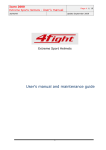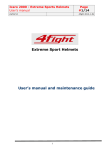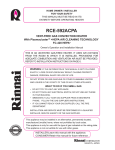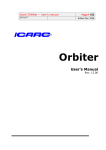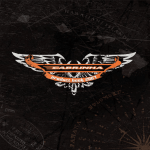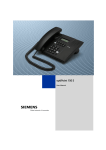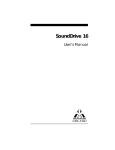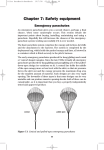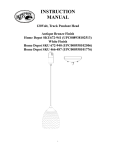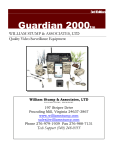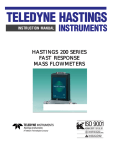Download Laminar Manual
Transcript
LAMINAR Hanggliders - User's Manual 24/05/00 Page # 1 / 25 Rev.99, jul Laminar Instructions Manual Rev.2000.1 1 LAMINAR Hanggliders - User's Manual 24/05/00 Page # 2 / 25 Rev.99, jul Congratulations on buying an Icaro 2000 hang-glider! We’re confident that you’ve made the right choice. The Laminar ST represents the biggest technological advance for many years; hang-gliding will never be the same again. Icaro 2000 srl is Europe's leading hang-glider manufacturer, having built over 6,000 gliders in the last decade. Icaro’s competition and sales record are the envy of other manufacturers. Icaro 2000 gliders are fully designed and manufactured, using only first quality materials, in our factory at Sangiano, in Northern Italy. All our hang gliders have at least German certification and many, have other international certifications too. With our extensive, world-wide distributor network, you can rest assured that parts and service are available to you no matter where you fly. Have fun!.... If you need any further information or services, please contact your nearest dealer, or directly . Icaro 2000 srl via Verdi, 19 21038-Sangiano, VA ITALY Ph. +39-0332-648-335 Fax +39-0332-648-079 e-mail: [email protected] website: http://www.icaro2000.com 2 LAMINAR Hanggliders - User's Manual 24/05/00 Page # 3 / 25 Rev.99, jul Table of Contents I. INTRODUCTION KEEP RISKS TO A MINIMUM 4 PRELIMINARIES 4 ASSEMBLY CHECK AND FIRST FLIGHT 4 HIGH FLIGHTS 4 II. FUNDAMENTAL RULES III. CERTIFICATION AND GENERAL LIMITS CERTIFICATION 5 WIND SPEED 5 TURBULENCE 5 AEROBATIC FLYING 6 IV. TRANSPORTATION BY CAR 6 BY GONDOLA OR CABLE CAR 6 BY PLANE 6 V. ASSEMBLY LAMINAR ST ’99 6 ON THE FRAME 7 FLAT ASSEMBLY 9 VI. CHECK LISTS ASSEMBLY CHECK 10 OTHER EQUIPMENT CHECK 11 PRE-FLIGHT CHECK 12 VII. DISASSEMBLY ON THE FRAME 12 FLAT DISASSEMBLY 14 VIII. HINTS AND TIPS VARIABLE GEOMETRY 15 TAKE-OFF 15 FLIGHT 16 LANDING 16 IX. REPAIR AND PERIODIC INSPECTION X. CHECKING THE REFLEX AND DIHEDRAL XI. TRIMMING TURNS 19 TRIM SPEED 19 XII. SHORT PACKING THE GLIDER XIII. TECHNICAL DATA XIV. MAINTENANCE LOG XV. OWNER'S LOG 4 5 5 6 6 10 12 15 16 18 19 19 21 24 25 LAMINAR Hanggliders - User's Manual 24/05/00 I. Page # 4 / 25 Rev.99, jul Introduction Over the last decade hang gliding has become much safer. Accidents have decreased, due to flight-schools becoming more professional, and certification procedures becoming more demanding. In Switzerland, for example, the insurance risk of hang gliding is the same as for winter sports. However, hang gliding is an active sport with associated risks. Your safety can be greatly enhanced by following a few simple rules: Keep risks to a minimum q q q q q q Attend a professional school. Fly a glider suited to your level of ability. Our Laminar models EZ, R and ST offer pilots an ideal range to upgrade accordingly to their experience. We recommend that you should have an advanced rating, and at least 100 hours air-time, before upgrading to the ST. Only fly when weather conditions are appropriate. Remain current. Try to avoid long intervals between one flight and the next so your flying ability will gradually improve Be aware of adverse weather conditions; caution is a mark of intelligence not of cowardice. A new risk may arise when you first fly a new type of glider. The reactions of your new glider may well differ from those of the glider you weare used to. In order to keep this risk low, we recommend that you gradually become familiar with your new glider. Preliminaries q q Study your manual before your first flight. Practise setting up and breaking down your glider as explained in the manual. Always follow the same assembly and pre-flight check routine; do not let yourself be distracted during these procedures. Assembly check and first flight q q q Every authorized ICARO 2000 dealer can test fly your glider -if requestedbefore delivery. Consider asking for it: you'll get your money's worth. Your dealer should also help you set up your glider for the first time and see you off on your maiden flight. We strongly recommend basebar wheels, especially for your first flights. High flights q q Always wait for ideal weather conditions for your first high flight. Experiment with different VG settings, roll reversals, slow flight, high speed flight, and stalls at an altitude of at least 150 m ~ 500 feet. LAMINAR Hanggliders - User's Manual 24/05/00 II. q q q q q q q q Page # 5 / 25 Rev.99, jul Fundamental Rules After major repairs, after remounting the sail, or after a long period of not flying, always choose a site to fly from that you are familiar with, and where it is possible to land immediately after take-off. Your glider is delivered to you ready to fly. Do not make any adjustments that are not described in this manual. Only fly after having attended a good school, recognized by your hang gliding federation. The owner's manual is not a substitute for the experience of an authorized dealer. Any pilot who is in doubt about any aspect of their glider should consult their dealer, or ICARO, for advice. Never fly alone. Before every take-off always do both an assembly check and a pre-flight check. Don’t push your luck! Only fly in places suited to hang gliding. It's your responsibility to know the limits of your glider, and the limits of your own experience. Don’t attempt towing of any kind, unless you have attended a recognized towing school. Always use base-bar wheels when towing III. Certification and General Limits Certification All ICARO 2000 hang gliders have at least German certification and many, have other international certifications too. Our gliders are rated by the German Federation -DHV, as follows: q class 2 (for intermediate pilots) - LaminarEZ q class 2-3 (for advanced pilots) - Laminar12R,13R, 13ST, 13ST mylar q class 3 (for advanced pilots) - Laminar14R, 14ST, 14ST mylar Wind speed q q When the wind speed is over 30 km/h (~ 20 mph) take-off becomes increasingly risky. In these conditions, consult with more experienced pilots before taking off. If in doubt, don’t fly. Turbulence q q In turbulent conditions, gusts of descending air can suddenly put the glider at a negative angle of attack; such negative loads must be avoided. Do not fly in turbulent conditions or on the lee side of a mountain; this is extremely risky in strong winds. LAMINAR Hanggliders - User's Manual 24/05/00 Page # 6 / 25 Rev.99, jul Aerobatic flying q q Aerobatic flight includes flying with bank angles in excess of 60 degrees, pitch angles in excess of 30 degrees, whip-stalls, wingovers, loops and spins. Aerobatic flight can be fatal and is, therefore, prohibited. IV. Transportation By Car Serious damage can be caused to the glider during car transportation; a well padded roof rack is necessary to avoid damage. For additional safety and support, we strongly suggest you install a front rack on your vehicle. There are good carriers on the market, expressly made to transport your glider; these can be easily assembled on normal roof racks. Ask your dealer for details. By Gondola or Cable car To avoid any damage when transporting your glider on the cable car it is advisable to be present to supervise the loading and unloading of the glider. By Plane Your glider needs to be thoroughly protected if it is to be transported by air. Use a wooden box, or stiff cardboard tube. These can be provided by your dealer, or ICARO. Always let the airline know the dimensions and weight of your glider, well in advance. V. Assembly There are two ways to assemble your glider: ON THE FRAME -this method protects the sail because it never touches the ground; the sail is not damaged by sharp stones or dirty ground. FLAT ASSEMBLY -this method is advisable in strong winds Note: In the following, left and right are from the pilot’s perspective when flying. Laminar ST ’99 The Laminar ST model 1999, has to be rigged in a slightly different way; therefore we will indicate the main differences below and the rest should be done as indicated on pages 8-10, common for all Laminar models. q The Starting Point (page 8) is the same. FIXING THE ALUMINIUM SPU’s q q Open the L-shaped zipper located in the middle of the wing. Pull the tensioning bungee and tension the glider half-way, hooking the LAMINAR Hanggliders - User's Manual 24/05/00 Page # 7 / 25 Rev.99, jul handle on the keel bolt. If the wind is not too strong you may, pull the end of the keel out, pressing the spring button to set it free, and stand the glider on it, this makes it easier to continue rigging the glider. q Take the main aluminium SPU and pull it back, in order to bring it out of the cloth wingrib, and then pull it torwards the outside. q Take the rear end, flat cut, and lift it until you are able to insert the front part into the adapter. Note:it’s better to do it with a loose sail therefore follow the instructions properly. q Make sure that the cable on the SPU is running freely parallel to the SPU and is NOT twisted around it. q Repeat the procedure for the other wing. q MOUNT THE FIBERGLASS TIP-WAND.(refer to page 8). q FIXING THE ALUMINIUM TIP RODS. Open the tip-rod zipper which is located on the double surface towards the end of the wing, near the leading edge. q Pull the tip rod out of the sail until you are able to rotate it positioning the flat cut end towards you. q Using both hands, pass the flat end through the strap located under batten # 10, near the end of the double surface. q Lift the rear end and insert the front part with the rounded bolt in the proper fitting, attached to the leading edge tube, until you hear a soft ‘click’. Note:it’s better to do it with a loose sail therefore follow the instructions properly. q Check that the cable is running freely parallel to the tip rod and is NOT twisted around it. q Close the zipper. q Repeat the same procedure on the other wing. q q INSERT ALL THE BATTENS . q Finish tensioning the glider and secure the lock plate on the keel bolt by means of the spring button. q Go back to each of the SPU’s and pass them through the security cords and close the L-shaped zippers. Insert the rear end of the keel in the main tube again and secure it with the spring button. Follow the instructions for FIXING THE CROSSBAR (see page 8) and for FINAL OPERATIONS (see page 9) q q On the Frame Place the glider on the ground, q In a light breeze: nose into the wind q In a moderate breeze: the keel must be perpendicular to the wind LAMINAR Hanggliders - User's Manual 24/05/00 Page # 8 / 25 Rev.99, jul If the ground where you are assembling the glider is not flat, point the nose of the glider toward the top of the slope STARTING POINT q q q q q q Open the bag, extend the uprights, and fix the speed-bar with the push-pin and safety washer. Do not forget the safety! Make sure that the curve of the base-bar faces the nose of the glider. Thread the cord of the variable geometry (VG) through the clamp on the speed bar (does not apply to EZ). Turn the glider over and stand it on the control frame. Remove the glider bag and any remaining ties. Open the wings keeping the end of the wings, protected by the tip covers, close to the ground. Only for EZ and R models: raise the kingpost, insert the cap with the top wires and attach the rear wire to the keel. Take the nose catch fixed to the bottom-front wires, and fix it with the pushpin to the nose of the glider. INSERTING THE BATTENS Red tipped battens are for the left wing, Green for the right one : bring them out of the bag and put them on the ground (appropriate side). q Beginning from the center of the glider insert the battens 1 to 6 (size 14 gliders) or 1 to 5 (size 12 and 13 gliders) of each wing into their pockets and double secure the bungees. Note: The nose batten can remain in the sail at all times q FIXING THE CROSSBAR q q Ensure that the VG system is completely loose (EZ has no VG) and the wings are fully open. Standing behind the glider, locate the crossbar tensioning cord near the keel. Pull the cord until you can reach the small plate with the lock hole, and secure it to the keel bolt by means of the spring button. MOUNTING THE FIBERGLASS TIP-WAND Remove the tip cover and open the wing-tip zipper. Insert the thick end of the fiberglass tip-wand through the opening of the sail on the end of the wing, and into the aluminum hole at the end of the leading edge. Push firmly until you hear it hitting against the stopper. q Bend the thin end of the tip-wand toward the trailing edge, and at the same time position the cup of the tip-lever over it. q Using the attached cord, push the tip-lever into the sail until it snaps shut against the tip-wand and the sail tightens. Warning : Keep your fingers clear while closing the lever q Close the wing-tip zipper. At this stage, the sail may not be flat but slightly twisted. If so, twist the end of the sail slightly to make it flat. Failing to do this could introduce a suddle turn while flying q q FIXING THE CARBON SPU's (does not apply to EZ and R models) q q Ensure that the VG system is completely loose. Open the L-shaped zipper in the middle of the wing. Swing the SPU across to LAMINAR Hanggliders - User's Manual 24/05/00 q Page # 9 / 25 Rev.99, jul the transverse batten near the trailing edge, and fix it using the supplied cord. Ensure that the complete SPU is inside the double surface (applies only to the ST models). Close the L-shaped zipper surface (applies only to the ST models). INSERTING THE REMAINING BATTENS q q Finish inserting and securing the remaining curved battens. Insert the straight battens in their under-surface pockets and secure them. FIXING THE ALUMINIUM TIP RODS Open the tip-rod zipper which is located on the double surface towards the end of the wing, near the leading edge. Plug the aluminium tip-rod tube into the rear-facing hole in the leading edge. An elastic cord keeps the tip-rod secured to the leading edge tube. Note: The end of the tip-rod keeps the trailing edge quite high; to make this operation easier lift the second-to-last curved batten. q Ensure that the tip-rod passes under the curved batten, and supports it. q Close the tip-rod zipper Repeat the same steps for the other wing. q FINAL OPERATIONS Unzip the double surface (under the keel), take the spring catch attached to the black belt, and fix it to the loop of webbing in the central sliding block. (ST13 this catch stays attached even while glider is not rigged). SHV-R and the ST models have it; DHV-R and the EZ models don't. Note: To make this easier, try pulling on a small amount of VG. q Fit the nose fairing q Check that the T-bar (if fitted) to which the hang-strap is connected, has swung out and is perpendicular to the keel (applies only to ST) Assembly is now complete: immediately do the assembly check. Warning : do not lift the keel if the glider is not tensioned, it may damage the nose bolts and plates. q Flat Assembly In order to do this you have to tension the glider, this is pulling the cord that runs parallel to the keel and hook the lock plate on the keel bolt, at the end. Place the glider on the ground, nose into wind STARTING POINT q q q q Open the bag, extend the uprights, and fix the speed-bar with the push-pin and safety washer. Do not forget the safety! Make sure that the curve of the base-bar faces the nose of the glider. Thread the VG cord through the speed-bar cleat (does not apply to the EZ). Turn the glider over and lie it flat on the ground. Remove the glider bag and any remaining ties. Open the wings, keeping them low to the ground. and disconnect the spring catch (12 and 13 ST only-13R is not suited for flat assembly) LAMINAR Hanggliders - User's Manual 24/05/00 Page # 10 / 25 Rev.99, jul Follow the same steps as for frame-based assembly (remember to pull the tension only at the end). FINAL OPERATIONS Stand the glider on its frame Take the nose catch fixed to the bottom-front wires, and fix it with the pushpin to the nose of the glider. q Open the central zipper, take the spring catch attached to the black belt, and fix it to the loop of webbing in the central sliding block. SHV-R and the ST models have it; DHV-R and the EZ models don't Note: To make this easier, try pulling on a small amount of VG. q Fit the nose fairing q Check that the T-bar (if fitted) to which the hang-strap is connected has swung out and is perpendicular to the keel (applies only to ST). Warning : do not lift the keel if the glider is not tensioned, it may damage the nose bolts and plates. Assembly is now complete: immediately do the assembly check. q q VI. Check Lists Before every flight it's imperative to do a systematic check of the glider Assembly Check Begin from the nose of the glider. Go counter-clockwise around the glider through all listed locations, opening and closing zippers where necessary to perform the checks. Finish by checking the center and the control frame. The following points need to be checked carefully : Nose q q The nose catch push-pin is attached and fully pushed through. The nose fairing fits properly. Central Left Wing q q q q The nut and bolt connecting the cross-bar and leading edge is secure. The side wire is in perfect condition. The crossbar is not damaged. The carbon SPU is in place and secured by its string (applies only to ST). Left Wing Tip q q q q q The nuts on the two leading edge bolts are secure. The tip-lever is fully tensioned. The end of the sail is flat. The aluminium tip rod is correctly inserted in the leading edge hole. The Leading Edge tube isn’t damaged. Left Wing Battens q q All the upper battens are double-bungeed in place. Lower battens are in place and secured. Rear Keel q All nuts and bolts on the rear section of the keel are secure. LAMINAR Hanggliders - User's Manual 24/05/00 q q q q Page # 11 / 25 Rev.99, jul The tension strap plate is securely in place and is well secured by the spring button. The tension strap itself is in good order. The lower rear wires are in perfect condition. The detachable rear section of the keel is properly seated in the main keel section, using the spring button. Right Wing Battens q see above : "Left Wing Battens" Right Wing Tip see above : "Left Wing Tip" Central Right Wing see above : "Central Left Wing" Central Section q q q q q The safety catch is connected to the webbing loop on the sliding central block of the crossbars. SHV-R and the ST models have it; DHV-R and the EZ models don't. The hang strap is not damaged and is well secured. The T-bar bolt for the hang strap is not bent. (If T-bar fitted and applies only to ST). Look inside the sail to make sure the main tubes are all right and all bolts are tight. The zipper is finally closed. Control Frame-Lower Corners q q q q The speed-bar is properly attached. The push-pins and their safety washers are in place The two socket head bolts which secure the speed-bar knuckles are tight and do not protrude from the nylon block The lower wires are not kinked or caught around the control frame. Kingpost (EZ and R models only). q q q The cap is properly positioned and the kingpost is straight. The luff lines are clear and not kinked. The cable is attached to the keel. Other Equipment Check Harness q q q q Parachute in place and handle secure Leg-straps in place and buckles secure Zipper unobstructed and running freely. Clip in and hang. On the ground, the center of the speed-bar is deformed about 5cm (~2 inches) upwards, compared to its position in flight. Allow for this when evaluating your height from the bar, you should leave a space of, at least, 10cm (~4.5 inches) LAMINAR Hanggliders - User's Manual 24/05/00 Page # 12 / 25 Rev.99, jul Helmet q Straps secure Pre-flight check q q q q q Hooked in Strength and direction of the wind are safe Nose angle is safe Wings are leveled Take-off area and glider are clear VII. Disassembly As with assembling your glider, disassembly can be performed either with the glider on the control frame, or with the glider lying flat on the ground Warning: You should only de-rig on the control-frame if the wind is light Laminar ST ’99 The Laminar ST model 1999, has to be disassembled in a slightly different way; therefore we will indicate the main differences below and the rest should be done as indicated on pages 12-14, common for all Laminar models. De-rigging the glider should be done in the opposite order as it was rigged; therefore the steps are as follows: Release the tensioning plate from the keel bolt and hook the handle on it. q Remove the battens. q Remove the aluminium tip rods. Make sure to have a loose sail before removing the tip wands and SPU’s. q Remove the fiberglass tip wand. q Remove the aluminium SPU’s. For these procedures refer to the instructions on pages 6-7 for glider assembly and for de-rigging instructions common for all Laminars see the instructions below. q On the Frame STARTING POINT q q q Stand the glider with its tail into wind. If possible, choose a slight dip to rest the base-bar, for better stability while de-rigging. Extract the rear-most section of keel by depressing the spring button and pulling the rear of the keel; this rear section remains attached via a bungee. Swing down the free section of the keel, allowing the main part to rest on top of it. LAMINAR Hanggliders - User's Manual 24/05/00 Page # 13 / 25 Rev.99, jul REMOVING THE BATTENS q q q q q q q With the crossbar tension still on, take the bungees off the curved battens and remove the last five. Remove the undersurface battens. Unzip the L-shaped zipper, release the carbon SPU from its cord, and swing it back to rest on the leading edge tube (applies only to the ST models). Unzip the tip-rod zipper and pull the tip-rod out of its socket. Lie it parallel to the back of the leading edge, with the shortest side facing the wing's end. Unzip the wing-tip zipper, grasp the tip-lever by the cord and pull it towards the outside. Holding the lever with one hand, and the tip-wand with the other, pull back the tip-lever, releasing the tip-wand from the cup. Remove the tip-wand from its socket and place it with the straight battens. Swing the tip-lever back inside the sail and close the zipper. FOLDING THE TIPS OF THE SAIL q q q q With one tip-bag in your pocket, stand in front of the leading edge. Take the tip of the sail in one hand, and pull it back along the underneath of the leading edge. Reach across the top of the glider, grasp the trailing edge of the sail where it meets the fold, and pull it towards you. This should leave a new fold running down to where the keel meets the trailing edge. Roll the sail away from you until it is tight. Bring the tip of the sail around the front of the leading edge and over the top of the wrapped sail. Holding the rolled sail, slip the tip-bag over the tip. FINAL OPERATIONS q q q q q q q q q q q q Repeat the same steps for the other wing. Replace the rear section of keel. Pack the battens and tip-wands in their bag. Remove the kingpost cable attached to the keel (applies to EZ and R models, only). Release the crossbar tension by depressing the spring button that holds the crossbar tensioning plate, and letting it slide back into the sail. Unzip the main undersurface zipper. Disconnect the crossbar safety clip from the webbing loop (ST13 this catch stays attached even while glider is not rigged). SHV-R and the ST models have it; DHV-R and the EZ models don't. Remove the nose fairing and disconnect the nose catch. Swing in the wingtips, keeping them close to the ground. Pull the loose sailcloth to the outside of the wings as you close them. Lower the kingpost, remove its cap and put on the protection (EZ and R models, only). Make sure that the hang-strap T-bar has swung around to lie parallel to the keel -if T-bar fitted (ST only). Roll up the remainder of the sail and fasten the glider ties. Ensure that where the leading edge cloth meets the uprights, it curves inwards and upwards to prevent damage. LAMINAR Hanggliders - User's Manual 24/05/00 q q q q q q Page # 14 / 25 Rev.99, jul Insert the nose fairing into the gap between the leading edge cloth and the internal mylar. Place the glider bag over the glider and swing the glider down onto its side. Detach the base-bar, clip the nose-catch into one of the base-bar knuckles, and place the padding bag over the end of the uprights. This keeps all catches and corners protected. Lie the uprights down, ensuring that the hang-strap and wires all pass between the two uprights and are not kinked. Place the battens and base-bar in the wing-tip end of the bag. You may need to temporarily unfasten one of the glider ties to do this. Zip up and go! Flat Disassembly The gliders will not lay flat when tensioned. Before starting, release the lock plate from the keel bolt by means of the spring button or release on of the A-frame’s push pins, always with VG off. STARTING POINT q q q q q q Hold the glider with its nose into wind. Unzip the main undersurface zipper. Disconnect the crossbar safety clip from the webbing loop (ST13 this catch stays attached even while glider is not rigged). SHV-R and the ST models have it; DHV-R and the EZ models don't. Remove the nose fairing and unclip the nose catch. Let the glider drop down flat onto the ground, by pulling it towards you. Release the crossbar tension by depressing the spring button that holds the crossbar tensioning plate, and letting it slide back into the sail. REMOVING THE BATTENS q q q q q q q Take the bungees off the curved battens and remove them. Remove the undersurface battens. Unzip the "L"-shaped zipper, release the carbon SPU from its cord, and swing it back to rest parallel to the leading edge (applies only to the ST models). Unzip the tip-rod zipper and pull the tip-rod out of its socket. Lie it parallel to the back of the leading edge, with the shortest side facing the wing's end. Unzip the wing-tip zipper, grasp the tip-lever by the cord and pull it towards the outside. Holding the lever with one hand, and the tip-wand with the other, pull back the tip-lever, releasing the tip-wand from the cup. Remove the tip-wand from its socket and place it with the straight battens. Swing the tip-lever back inside the sail and close the zipper. FOLDING THE TIPS OF THE SAIL q With one tip-bag in your pocket, stand in front of the leading edge. Take the tip of the sail in one hand, and pull it back along the underneath of the leading edge. LAMINAR Hanggliders - User's Manual 24/05/00 q q q Page # 15 / 25 Rev.99, jul Reach across the top of the glider, grasp the trailing edge of the sail where it meets the fold, and pull it towards you. This should leave a new fold running down to where the keel meets the trailing edge. Roll the sail away from you until it is tight. Bring the tip of the sail around the front of the leading edge and over the top of the wrapped sail. Holding the rolled sail, slip the tip-bag over the tip. FINAL OPERATIONS q q q q q q q q q q Repeat the same steps for the other wing. Pack the battens and tip-wands into their bag. Swing in the wingtips, keeping them close to the ground. Pull the loose sailcloth to the outside of the wings as you close them. Roll up the remainder of the sail and fasten the glider ties. Ensure that where the leading edge cloth meets the uprights, it curves inwards and upwards to prevent damage. Insert the nose fairing into the gap between the leading edge cloth and the mylar. Place the glider bag over the glider and turn the glider upside down. Detach the base-bar, clip the nose-catch into one of the base-bar knuckles, and place the padding bag over the end of the uprights. This keeps all catches and corners protected by padding. Lie the uprights down, ensuring that the hang-strap and wires all pass between the two uprights and are not kinked. Place the battens and base-bar in the wing-tip end of the bag. You may need to temporarily unfasten one of the glider ties to do this. Zip up and go! VIII. Hints and Tips Variable Geometry The Laminar ST and R are fitted with a very effective variable geometry (VG). Pulling on the VG cord moves the crossbar backwards, thereby increasing the nose angle and tightening the sail. This improves the sink-rate and glide-angle. With the VG slacker, the handling is improved, for take-off, landing, and thermalling. Take-off Before take-off, pull on up to 50cm (~20 inches) of VG. This improves groundhandling by keeping the lower wires tight. If there are strong thermals near the take-off area, it is advisable to let the VG completely loose. The launch characteristics of the Laminar are forgiving enough that you can get away with minor take-off errors, such as nose angle a little too high or takeoff speed a little slow. Try to take off with a nose angle of about 15 degrees above the slope, and with as much speed as possible (never lower than the stall speed!) Don’t take off if the sail is wet, especially the leading edge, as the stall speed will LAMINAR Hanggliders - User's Manual 24/05/00 Page # 16 / 25 Rev.99, jul have increased significantly. WARNING : Always fly with a dry sail ! Flight The Laminar is one of the few high performance gliders that is very easy to fly. Thanks to the efficient VG system every pilot can adapt it to his or her own needs. The Laminar is responsive and pleasant to fly throughout the speed range. Landing When landing, it is advisable to keep the variable geometry pulled in no more than one third (1/3) of its full length, so that the glider will respond quickly to every maneuver. If landing in very turbulent conditions is better to have the VG off. After the landing approach, make the final leg into the wind, with a medium-high speed. When you are near the ground slightly reduce your speed, then keep flying parallel to the ground, gradually easing out the bar. As soon as you feel the glider start to stall, flare. The less wind in the landing field the harder you need to flare. If there is more than 16km/h (~10mph), in the landing field, you should not need to flare at all. IX. Repair And Periodic Inspection Every year, or after 100 flight hours (MANDATORY): q q q Replace all the bottom wires. Check the curve of your battens with the supplied drawing. Check the reflex and dihedral as described in the next chapter. Every two years: q q Remove the sail and carefully check the frame for bends, dents, corrosion or other damage. Check that all bolts are tight. Every five years: q Have a check done by an authorized dealer or by our workshop (this check, done by qualified personnel, is obligatory in Germany). After a crash or heavy landing q q Carefully check your whole glider Check particularly the part of the glider that has been hit in the crash Replace the damaged parts with original parts only If you have any doubt about the damaged parts call an ICARO 2000 agent, or our workshop; we will be pleased to advise you. When dismounting your glider, take care to notice exactly how each component is connected. Never rush a repair job. By taking your time, you’re far less likely to LAMINAR Hanggliders - User's Manual 24/05/00 Page # 17 / 25 Rev.99, jul make a mistake in reassembly. Furthermore, treated with care, your glider will last much longer. General Advice: q q q q q q The wires must be periodically checked for kinks or broken strands. Dirty parts must be cleaned with warm water. A wet glider must be dried before storing. Don’t leave your glider wet for more than a day or so, because mildew and corrosion may result. When opening the glider be careful the sail doesn’t get dirty. Salt water causes oxidation on all metallic parts. If you land in the sea and survive, you must disassemble the entire glider, and wash all tubes, bolts, wires, and the sail very thoroughly with fresh water. If you fly regularly at the coast in windy conditions, be aware that sea spray can have the same effect. Hose down your glider after such flights, and keep a special lookout for corrosion. LAMINAR Hanggliders - User's Manual Page # 18 / 25 24/05/00 X. Rev.99, jul Checking the Reflex and Dihedral Because your Laminar ST has no top-rigging, it achieves pitch-stability through the use of the internal SPU's. The amount of reflex and dihedral is extremely important. The following checks should be performed with the glider fully rigged. This may also be checked by Laminars R and EZ. Three points are defined: q Points 1 and 2 (ST), 1-4 (R and EZ) are on the trailing edge and are used for checking the reflex. These tests should be performed with VG on its tightest setting, and the keel supported so that it is horizontal. Battens are numbered outwards from the keel. q Point 3 is at the end of the outer leading edge tube, where the tip-wand is inserted, and is used for checking the dihedral. This test should be performed with the glider lying on its back, the VG on its tightest setting, and the sidewires tight. For each test, take a length of nylon fishing line, and stretch it tightly between the corresponding points on each wing. Measure the vertical distance from the line to the top edge of the keel. In each case, the measurement must be within the tolerances shown in the following tables: New System model ’99 and on Point 1 Point 2 Batten #7 #9 L13ST Height mm 40 ± 5 25 ± 5 With Carbon SPU (old system) Point 1 Point 2 Point 3 Batten #6 #9 n/a L12ST Height mm 90 ± 5 85 ± 5 180 ± 10 Batten #6 #9 n/a L13ST Height mm 65 ± 5 30 ± 5 280 ± 10 Batten #7 #10 n/a Point 1 Point 2 Point 3 Point 4 Point 5 Batten #4 #5 #6 #7 n/a L12R Height mm 170 ± 5 200 ± 5 195 ± 5 190 ± 5 190 ± 10 Batten #3 #4 #5 #6 n/a L13R Height mm 80 ± 5 100 ± 5 110 ± 5 100 ± 5 270 ± 10 Batten #4 #5 #6 #7 n/a Point 1 Point 2 Point 3 Point 4 Point 5 Batten #3 #4 #5 #6 n/a L14EZ Height mm 90 ± 5 100 ± 5 120 ± 5 90 ± 5 150 ± 10 L14ST Batten #8 #10 Height mm 45 ± 5 15 ± 5 L14ST Height mm 85 ± 5 10 ± 5 250 ± 10 L14R Height mm 55 ± 5 70 ± 5 60 ± 5 30 ± 5 310 ± 10 LAMINAR Hanggliders - User's Manual 24/05/00 Page # 19 / 25 Rev.99, jul NOTE: the same edge of the keel is used for all measurements. In other words, for point 3, the edge of the keel that is now lowest to the ground is the one to use. If your measurements fall outside the limits, you should send your glider to an authorized ICARO workshop to be adjusted. XI. Trimming During the assembly of your glider, the sail has to be mounted on the frame in such a way that the sail tension is perfectly symmetrical. The tension of the sail can be adjusted either by varying the tension of the tiplevers, or the tension of the batten bungees. Turns If the glider does not fly straight, please check: q The battens' airfoil using the supplied batten profile. q That the tension of the sail on the left tip-wand is the same as on the right one. q That the nylon bung into which the tip-wand is seated is undamaged and seats the tip-wand perfectly. q That the leading edges and all other tubes are undamaged. If the glider still turns: q Turn the nylon bung no more than 15mm (~5/8 inch) clockwise on the leading edge to which the glider turns. Trim Speed q q q It is possible to change the trim speed by moving the hang point into one of the 6 holes on the keel. Moving the hang point forwards causes the glider to fly faster (and vice versa) Only move the hang-point one hole at a time. The maximum forward and aft positions are restricted to the keel holes provided. XII. Short packing the glider You should avoid short-packing the glider unless absolutely necessary. It causes unnecessary wear and tear on both the sail and the leading edge's mylar. If you do need to short-pack your glider for transport: q be sure to mark where each part goes q remove the sail mounting pin from the end of the outer leading edge q push the button on the top of the leading edge tube, and slip it off. q You'll find he g it on the ST14 model roughly at 120cm (4’0") and on the ST13 at 95cm (3’2") Laminar cm inches q 14EZ 160.1 63.0 12R 157.5 62.0 13R 94.4 37.2 14R 119.2 46.9 cover the exposed tube with soft padding 12ST 157.5 62.0 13ST 119.2 46.9 14ST 119.2 46.9 LAMINAR Hanggliders - User's Manual 24/05/00 Page # 20 / 25 Rev.99, jul fold the sail as normal, just past the end of the shortened wing. Note: when you re-assemble the leading edge, be sure to check that the push-pin is sticking out from the tube q LAMINAR Hanggliders - User's Manual 24/05/00 Rev.99, jul XIII. Technical Data Laminar 12ST Sail Area Nose Angle Wingspread Aspect Ratio Double Surface Area Battens (Upper + Lower Sail) Weight (Packing Bag Not Included) Clip-In Pilot Weight (Min / Max) Packing Bag Length Short-Packed Length CERTIFICATION Page # 21 / 25 UoM sq m sq ft deg m ft % n kg kg m m lb lb ft ft L 12 ST 12.5 134.55 130 9,90 32.48 7,84 86% 21+6 30.5 67 50 / 85 110 / 187 4,90 16.08 3,70 12.14 dhv Laminar 13ST UoM L 13 ST Sail Area sq m sq ft 13,2 142.08 Nose Angle deg 130 Wingspread m ft 10,02 32.87 Aspect Ratio 7,60 Double Surface Area % 88% Battens (Upper + Lower Sail) n 21+6 Weight (Packing Bag Not Included) kg lb 32 71 Clip-In Pilot Weight (Min / Max) kg lb 60 / 90 132/ 198 Packing Bag Length m ft 4,98 16.34 Short-Packed Length m ft 4,15 13.62 CERTIFICATION dhv / shv Laminar 14ST UoM L 14 ST Sail Area sq m sq ft 14,4 155.00 Nose Angle deg 130 Wingspread m ft 10,40 34.12 Aspect Ratio 7,51 Double Surface Area % 87% Battens (Upper + Lower Sail) n 23+6 Weight (Packing Bag Not Included) kg lb 34 75 Clip-In Pilot Weight (Min / Max) kg lb 75 / 110 165 / 243 Packing Bag Length m ft 5,20 17.06 Short-Packed Length m ft 4,15 13.62 CERTIFICATION dhv / shv LAMINAR Hanggliders - User's Manual 24/05/00 Rev.99, jul Laminar 12R Sail Area Nose Angle Wingspread Aspect Ratio Double Surface Area Battens (Upper + Lower Sail) Weight (Packing Bag Not Included) Clip-In Pilot Weight (Min / Max) Packing Bag Length Short-Packed Length CERTIFICATION UoM sq m sq ft deg m ft % n kg kg m| m| lb lb ft ft L12 R 134.55 130 9.90 32.48 7.84 86% 21+4 29 64 50 / 85 110 / 187 4.90 16.08 3.70 12.14 dhv 12.5 Laminar 13R Sail Area Nose Angle Wingspread Aspect Ratio Double Surface Area Battens (Upper + Lower Sail) Weight (Packing Bag Not Included) Clip-In Pilot Weight (Min / Max) Packing Bag Length Short-Packed Length CERTIFICATION UoM sq m sq ft deg m ft % n kg kg m| m| lb lb ft ft L13 R 13.2 142.08 130 10.02 32.87 7.60 86% 21+4 30 66 60 / 90 132 / 198 4.98 16.34 4.15 13.62 dhv / shv Laminar 14R Sail Area Nose Angle Wingspread Aspect Ratio Double Surface Area Battens (Upper + Lower Sail) Weight (Packing Bag Not Included) Clip-In Pilot Weight (Min / Max) Packing Bag Length Short-Packed Length CERTIFICATION Page # 22 / 25 UoM sq m sq ft deg m ft % n kg kg m| m| lb lb ft ft L14 R 14.4 155.00 130 10.40 34.12 7.51 86% 23+4 32.5 72 70 / 110 154 / 243 5.20 17.06 4,15 | 13.62 dhv / shv LAMINAR Hanggliders - User's Manual 24/05/00 Page # 23 / 25 Rev.99, jul Laminar 14EZ Sail Area Nose Angle Wingspread Aspect Ratio Double Surface Area Battens (Upper + Lower Sail) Weight (Packing Bag Not Included) Clip-In Pilot Weight (Min / Max) Packing Bag Length Short-Packed Length CERTIFICATION UoM sq m sq ft deg m ft % n Kg Kg m m lb lb ft ft L14EZ 14.5 156.08 127° 10.3 33'79'' 7.3 80 17+4 28 61.73 65/95 143/209 5,20 17'1'' 4 13'12'' dhv Laminar 16EZ Sail Area Nose Angle Wingspread Aspect Ratio Double Surface Area Battens (Upper + Lower Sail) Weight (Packing Bag Not Included) Clip-In Pilot Weight (Min / Max) Packing Bag Length Short-Packed Length CERTIFICATION UoM sq m sq ft deg m ft % n Kg Kg m m lb lb ft ft L16EZ 15.7 168.99 127° 10.3 34’44” 7.0 74 17+4 30 67.34 75/110 165/242 5,20 17'7'' 4 13'12'' LAMINAR Hanggliders - User's Manual 24/05/00 Page # 24 / 25 Rev.99, jul XIV. Maintenance Log Enter here the details of any modifications or repairs that are made to your glider. Date Modification or Repair LAMINAR Hanggliders - User's Manual 24/05/00 Page # 25 / 25 Rev.99, jul XV. Owner's Log This log provides a history of the glider's ownership. Please make sure details are correct when you sell the glider. Purchase Name Date Phone Address

























